|
NFL Championship Games
1937: Washington Redskins @ Chicago BearsThis series covers the history of the NFL through the prism of its yearly championship games.
Note: The gray boxes contain asides that provide interesting material but could be skipped without losing the continuity of the article.

George Marshall
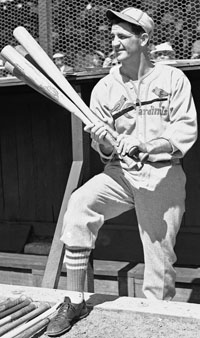
Slingin' Sammy Baugh
|
Many thought the Boston Redskins' Eastern Division championship in 1936 was a fluke.
- Three teams in the West, Green Bay, Chicago, and Detroit, had better records than any eastern team. Someone had to win the East, and the Redskins did by winning their last three games over division foes.
- They certainly hadn't enjoyed a home field advantage since owner George Preston Marshall alienated Hub City fans by blasting them during the season for not supporting his team.
But after moving his team to Washington, Marshall made one of the best draft decisions in NFL history.
- Putting fannies in the seats at Griffith Stadium required a winning team led by a player fans would pay to see. The man George had his eye on was 6'2" 185 lb TB Sammy Baugh, who had set all sorts of passing and punting records at TCU. He was also a fine defensive back and an excellent punter.
- Imagine Marshall's surprise when Baugh was still available for the Redskins' #6 pick in the 1937 draft. (None of the first five picks played past 1940.)
- Two factors may have entered into teams' reluctance to select Sam. First, the baseball Cardinals coveted him as well, which would up the ante ($$$) to sign him. Secondly, the greatest sports writer of the age, Grantland Rice, wrote a column addressed to the Washington owner: You better insure that right arm for a million dollars. The tough guys in this league will tear it off him. He just isn't big enough to take the pounding he's going to get. I have my doubts that a skinny kid like that can last more than a season or two.
Sam Baugh had numerous options after he led TCU to its 1937 Cotton Bowl victory over Marquette.
- He considered baseball his best sport. It was as a third baseman that he earned the nickname "Slingin' Sammy" from a sports writer.
- Branch Rickey's Cardinals signed Sam to a pro contract when the 1936-7 college year ended and sent him to Columbus, where he was moved to shortstop. That put him at the same spot as another young Redbird farmhand named Marty Marion.
- Baugh knew he would never be as good as Marty. The other [problem], he recalled, was I couldn't hit that curve very well. So I left in August to play football, and after that I stuck with football.
- His first game was the annual college All-Star game in Chicago. He led the youngsters to a 6-0 upset of the defending champion Packers.
- After initially rejecting Marshall's offer of $5,000, Sam signed for $8,000, nearly double the average player salary and more than star RB Cliff Battles made after five years in the league. Baugh later said, When I found out what the rest of the players were making, I felt badly about asking for so much money.
Sam played 16 NFL seasons - take that, Grantland!
- He made first-team All-Pro four times and played in the Pro Bowl six times.
- The Texas gunslinger led the NFL in completions five times and in passing yardage four times.
- He also produced the best punting average four straight years starting with an incredible 51.4 in 1940, a record that still stands.
- Sam topped the league in interceptions in 1943 with 11 - passes he picked off as a defensive back, not ones he threw - and had 31 altogether before two-platoon football took over after World War II.
- That combination of records makes a solid case that Sam Adrian Baugh is the greatest football player of all time.
|
Marshall got more than he could have hoped for in his new field general.
- Blessed with a coach, Ray Flaherty, who appreciated the passing game more than many of his contemporaries, Baugh set the league on fire his rookie season. He could throw accurately with several different motions as the situation warranted. Sometimes he whipped the ball sidearm out of a wide stance. He explained, I practiced it that way, running sideways or backing up. You do it the hard way during practice and it comes easier during the game. He immediately demonstrated to the NFL that you could move the ball down the field with short passes. In other words, the forward pass could be more than a desperation measure.
- The Skins went 8-3 to win the East again over the 6-3-2 Giants.
- The 9-1-1 Bears regained the West crown from the 7-4 Packers in a division that included a new franchise for '37, the Cleveland Rams.
The Nation's Capital took to pro football right away.
- 24,000 gathered for the first home game, against the Giants on a Thursday night (under lights that George paid to install), and attendance continued strong throughout the season.
- The Redskins averaged 16,250 per game after not drawing that many for even one game in Boston the year before.
- 30,000 attended the final contest in Griffith Stadium, a 14-6 victory over the Packers that set up a showdown with the Giants the next Sunday.
- For the second year in a row, the Redskins could win the East by winning the final game at the Polo Grounds.
Marshall's promotional flair overflowed for the occasion.
Thousands of devoted fans traveled by bus, car, and train to support the Redskins. "I never saw a town go so football mad in my life," Coach Ray Flaherty told the Washington Evening Star. Marshall also brought the band. Dressed in burgundy-and-gold uniforms with Indian feather headwear, the band marched up Fifth Avenue to Columbus Circle playing "Dixie" and "Hail to the Redskins." Bill Corum of the New York Journal-American observed: "At the head of a one hundred and fifty piece brass band, and ten thousand fans, George Preston Marshall slipped unobtrusively into New York today." (Thomas G. Smith)
George also utilized what today would be called "trash talk" to hype the game at the Polo Grounds.
- Referring to the fact that his team had beaten the Giants two in a row, he said, It's a habit, a custom with us to beat those fellows. It's becoming a tradition. ... We'll sweep those fellows aside like rubbish.
- The game, he claimed, would be a good tune-up for the championship game the following week. Better come out to Chicago and see the big game later. Watch us win the national title.
- 55,000 fans, the second largest crowd in NFL history, saw the Redskins back up their owner's boast with an overwhelming 49-14 triumph.
- When the train carrying the Washington entourage returned to the Capital, Marshall tried to restage the Big Apple parade up Pennsylvania Avenue, but police halted it because of the lateness of the hour and the fact that he didn't have a permit. When he ordered the band to proceed anyway, the gendarmes arrested the drum major, necessitating Marshall paying a $25 fine for him in the wee hours.
The Redskins' potent offense would face the league's best defense in the title game.
- Flaherty ran the pass-friendly double wing formation that Baugh had mastered at TCU. This was not the T-formation but rather the single wing with two backs split out. It most resembled today's shotgun formation.
- As a result, Washington led the NFL in passes attempted (222) and completed (99). Sam topped the league in passing yards by a wide margin, 1127 to 824.
- Benefitting from the pressure the passing game took off him, Battles ranked #1 in rushing yards with 924, a whopping 322 more than the second place man.
1937 Chicago Bears
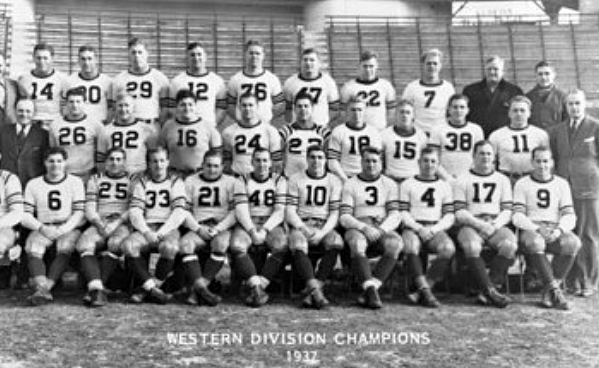
The West champions, on the other hand, surrendered the fewest points, 100, twenty fewer than the Skins.
- But Halas's T-formation offense, the only one in the league, was a formidable force also, running plays from six formations, an impressive number in 1937.
- In fact, Chicago actually scored more points than the Redskins (201-195), and QB Bernie Masterson led the league in touchdown passes with 9. He also had a higher passer rating (a statistic retroactively computed in recent years) than Baugh, 67.8-50.5.
- The Bears also had another arrow in their quiver in the person of RB Jack Manders, who led the league in field goals with eight, three more than Riley Smith of Washington.
- Halas had done a good job of freshening his roster with young players, including second-year T Joe Stydahar and rookie ends Dick Plasman, George Wilson, and Les McDonald.
For once, the Bears were not the unanimous favorite in the championship game.
- The two teams hadn't met during the season; so it was hard to compare them. But the Redskins' thumping of the Giants in the finale impressed the oddsmakers.
- Baugh and his band arrived in the Windy City two days before the game to find the mercury shivering at zero and drastic measures being taken to put the field in shape.
- The grounds crew drove asphalt burners up and down the Wrigley Field playing surface to thaw the surface. Workers spread a thick blanket of hay over the field and covered it all with a tarpaulin.
- The kickoff was moved up 45 minutes to 1:15 because of the fiasco caused by darkness at the end of the previous week's game in Wrigley Field. Read about that game ...
|
1937 Chicago Bears
| # |
Player |
Pos. |
Wgt. |
Hgt. |
College |
Exp. |
| 3 |
Bronko Nagurski |
FB/T |
6-2 |
238 |
Minnesota |
8 |
| 4 |
Keith Molesworth |
DB |
5-10 |
167 |
Monmouth |
7 |
| 5 |
George Corbett* |
HB/DB |
5-9 |
179 |
Millikin (IL) |
6 |
| 6 |
Gene Ronzani |
QB/DB |
5-10 |
190 |
Marquette |
5 |
| 7 |
Pug Rentner |
DB |
6-1 |
187 |
Northwestern |
4 |
| 8 |
Carl Brumbaugh* |
QB/DB |
5-10 |
170 |
Florida |
7 |
| 9 |
John Bettridge* |
FB/LB |
5-10 |
188 |
Ohio State |
2 |
| 9 |
Ray Buivid |
QB/DB |
6-1 |
195 |
Marquette |
1 |
| 10 |
Jack Manders |
FB/LB |
6-1 |
203 |
Minnesota |
5 |
| 11 |
John Doehring* |
HB/DB |
6-0 |
216 |
--- |
6 |
| 12 |
Frank Sullivan |
C/LB |
6-3 |
203 |
Loyola (N.O.) |
3 |
| 13 |
Joe Stydahar |
T |
6-4 |
230 |
West Virginia |
2 |
| 14 |
Dick Plasman |
E/T |
6-3 |
210 |
Vanderbilt |
1 |
| 15 |
Henry Hammond* |
E |
5-11 |
190 |
Rhodes |
1 |
| 16 |
George Musso |
G/T |
6-2 |
258 |
Millikin (IL) |
5 |
| 17 |
Joe Zeller |
G/E |
6-1 |
203 |
Indiana |
6 |
| 18 |
Edgar Manske |
E |
6-1 |
185 |
Northwestern |
3 |
| 21 |
Danny Fortmann |
G/LB |
6-0 |
210 |
Colgate |
2 |
| 22 |
Bill Karr |
E |
6-1 |
190 |
West Virginia |
5 |
| 23 |
Vern Oech* |
G |
6-1 |
207 |
Minnesota |
2 |
| 24 |
Frank Bausch |
C/LB |
6-3 |
224 |
Kansas |
4 |
| 25 |
Ray Nolting |
HB/DB |
5-11 |
188 |
Cincinnati |
2 |
| 26 |
Kay Bell* |
T/G |
6-2 |
220 |
Washington State |
1 |
| 27 |
Milt Trost |
T/E |
6-1 |
206 |
Marquette |
3 |
| 29 |
Russ Thompson |
T |
6-5 |
249 |
Nebraska |
2 |
| 30 |
George Wilson |
E |
6-1 |
190 |
Northwestern |
1 |
| 33 |
Bernie Masterson |
QB |
6-3 |
195 |
Nebraska |
4 |
| 38 |
Sam Francis |
FB/DB |
6-1 |
207 |
Nebraska |
1 |
| 47 |
Bill Conkright |
C/LB |
6-1 |
203 |
Oklahoma |
1 |
| 48 |
Beattie Feathers |
HB/DB |
5-11 |
177 |
Tennessee |
4 |
| 76 |
Les McDonald |
E |
6-4 |
202 |
Nebraska |
1 |
| 82 |
Del Bjork |
T |
6-1 |
218 |
Oregon |
1 |
|
1937 Washington Redskins
| # |
Player |
Pos. |
Wgt. |
Hgt. |
College |
Exp. |
| 11 |
Ernie Pinckert |
WB/DB |
195 |
6-0 |
Southern California |
6 |
| 12 |
Eddie Britt |
FB/DB |
205 |
6-2 |
Holy Cross |
2 |
| 13 |
Ed Justice |
WB/DB |
205 |
6-1 |
Gonzaga |
2 |
| 15 |
Jim Barber |
T |
215 |
6-3 |
San Francisco |
3 |
| 17 |
Turk Edwards (C) |
T |
255 |
6-2 |
Washington State |
6 |
| 18 |
Eddie Michaels |
G |
195 |
5-10 |
Villanova |
2 |
| 19 |
Charlie Malone |
E |
210 |
6-4 |
Texas A&M |
4 |
| 20 |
Cliff Battles |
TB |
195 |
6-1 |
West Virginia Wesleyan |
6 |
| 21 |
Les Olsson |
G |
250 |
5-10 |
Mercer |
4 |
| 22 |
Chuck Bond |
T |
240 |
6-2 |
Washington |
1 |
| 23 |
Don Irwin |
FB |
200 |
6-1 |
Colgate |
2 |
| 25 |
Max Krause |
BB/DB |
198 |
5-11 |
Gonzaga |
5 |
| 26 |
Victor Carroll |
T/G |
225 |
6-3 |
Nevada-Reno |
2 |
| 28 |
Nelson Peterson* |
WB/DB |
179 |
5-8 |
West Virginia Wesleyan |
1 |
| 29 |
Jim Karcher |
G |
207 |
6-0 |
Ohio State |
2 |
| 30 |
Dixie Howell |
TB/DB |
175 |
5-11 |
Alabama |
1 |
| 32 |
Bob McChesney |
E |
195 |
6-2 |
UCLA |
2 |
| 33 |
Sammy Baugh |
QB/DB |
185 |
6-2 |
TCU |
1 |
| 35 |
Riley Smith |
BB/LB |
200 |
6-2 |
Alabama |
2 |
| 37 |
Bill Young |
T |
240 |
6-2 |
Alabama |
1 |
| 38 |
Ben Smith |
E |
208 |
6-3 |
Alabama |
4 |
| 39 |
Eddie Kawal |
C/LB |
198 |
6-2 |
Widener |
5 |
| 40 |
Wayne Millner |
E |
190 |
6-0 |
Notre Dame |
2 |
| 41 |
Henry Krause |
BB/DB |
215 |
6-1 |
St. Louis |
2 |
| 43 |
Eddie Kahn |
G |
195 |
5-9 |
North Carolina |
3 |
| 47 |
George Smith |
C |
205 |
6-0 |
California |
1 |
* = inactive for championship game
Weights and heights from the New York Times the day of the game |
|
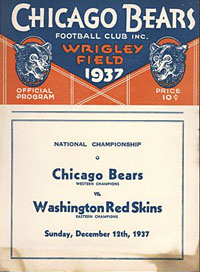

Bronko Nagurski breaks loose.
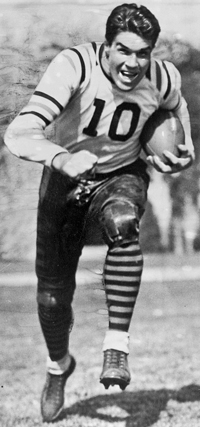
Jack Manders
|
The high temperature in Chicago that Sunday was 24° (after falling below zero a few days earlier), and the field was just icy enough to give the receivers a half step on their defenders.
- Decades later, Baugh remembered the worst field I've ever played on in my life. ... A week or so before that they had a playoff game .... and it had rained and got real muddy. Hell, they just chewed up the field. Well, when we got on it, ... the ground had froze up. There were all these little frozen balls of mud, hard and sharp as rocks, all over that damn field. They cut the living hell out of you when you hit the ground. A lot of people got chewed up pretty bad that day.
- Taking their cue from the 1934 Giants, both teams wore rubber-soled basketball shoes.
- The anticipated 40,000+ spectators turned out to be just 15,878 because of the frigid conditions.
- Halas prepared a special defense for the game. He deployed only five defensive linemen instead of the usual six, dropping an extra defender to cover Sammy's receivers coming downfield quickly from the Redskins' double wing formation.
- Quarter 1
The Redskins kicked off to the goal line. The Bear returner slipped as soon as he caught the ball but got up quickly and ran out to the 32. Bronko Nagurski rambled through a big hole at left tackle for a first down. But the drive soon bogged down, and Ray Nolting punted out of bounds on the nine.
A preview of how the day would go and an example of why Eastern writers credited Baugh with "opening up" the game of football, came on the Redskins' opening play from scrimmage. Slingin' Sam lined up in what appeared to be punt formation in the end zone. But taking the snap, he ran to his right and lofted a pass to Battles in Coach Flaherty's version of today's screen pass, a tactic designed to thwart the Bear rush. Aided by some fantastic downfield blocking, Cliff ran all the way to the Chicago 49. But Washington couldn't move much further and had to punt.
But the sudden change in field position benefitted them when they got the ball back at their 48. Two more of Flaherty's "flare passes" to backs, as they would be called today, moved the ball to a first down at the 20. One went to BB Riley Smith as Baugh ran right but moved backward to avoid the rush, and Ernie Pinckert caught the second. Then it was Baugh and Battles on the ground the rest of the way with Cliff slithering the final seven through left tackle to break the scoring ice with five minutes remaining. Smith booted the first of four PATs on the day. Redskins 7 Bears 0
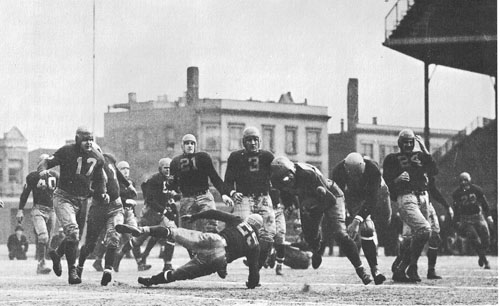
Cliff Battles scores the first touchdown of the game.
But the Bears surged back with two touchdowns by Manders in the next 5 1/2 minutes to take the lead. After the kickoff return to the 29, Bernie Masterson teamed up with Manders for a 51y pass and run. Shortly afterward, Nagurski gained seven to the 11. Then, with a man in motion taking at least one defender out of the middle of the field, Jack broke free through center for the touchdown. Automatic Jack also kicked the point to tie the score. Redskins 7 Bears 7
An interception at midfield set the go-ahead drive in motion. With the ball at the 38, Masterson looped a pass to Manders cutting across the field to the right 10y beyond the line of scrimmage. Benefitting from a nice block by George Wilson that Battles thought was holding, Jack ran as fast as he could on the slippery turf to the end zone. Bears 14 Redskins 7
|
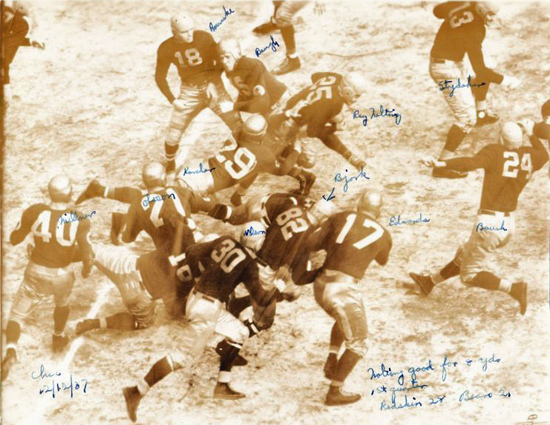
Ray Nolting (25) gains yardage in the first quarter.
- Quarter 2
Baugh, who had the heel of his right hand skinned raw in the opening period, left the game after a savage tackle severely bruised his right hip.
With the Slinger out of action, the Redskins never made it past midfield the whole period.
Flaherty needed his defense to hold the fort, and they did exactly that, keeping the score at 14-7. Halas's crew drove close enough for Manders to attempt two field goals, one from the 38 and the other from the 40, but both fell well short. Halftime score: Bears 14 Redskins 7

Baugh crashed to the frozen turf.
- Quarter 3
Limping perceptibly on his right leg and plainly suffering from the cold weather, Flaherty's prize cripple started the period and immediately tied the score. The Redskins traveled 70y in only four plays. The topper came when Sammy fired a flat-footed pass from his 45 to E Wayne Millner sprinting across to the right. Masterson horse-collared Wayne inside the five but succeeded only in slinging him down at the goal line. Bears 14 Redskins 14
But the Bears were still hot even if the day was cold. Halas reverted to age-old strategy. Manders, Nagurski, and Ray Nolting alternated carrying the ball until the Bears gained a first down at the four. But the Redskins stiffened, batting down two passes and stopping Nagurski for no gain. Eschewing the easy field goal, Masterson bobbled the snap from center but gained control, jumped, and flicked a pass to Edgar "Eggs" Manske in the end zone. Bears 21 Redskins 14
Undaunted, Baugh needed only one play to re-tie the game this time. Falling backward with a rusher in his face, he tossed 15y to Millner, and the man who would become known as "The Money Player" outraced Manders and Nagurski the remaining 63y to pay dirt. Bears 21 Redskins 21
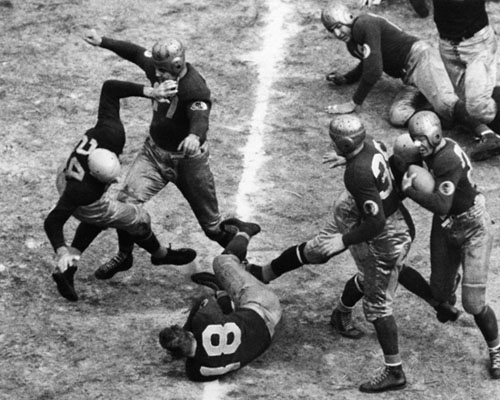
Battles follows Riley Smith (33) as Turk Edwards (17) blocks Frank Bausch (24) and
helmetless "Eggs" Manske falls to the turf.
|
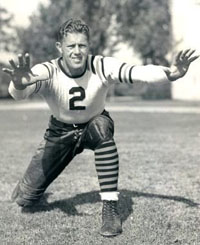
Dick Plasman
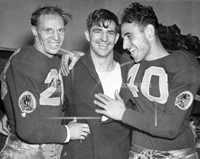
Battles, Baugh, and Millner afterwards
|
- Quarter 4
The Bears reached midfield before having to punt. FB Don Irwin on the ground and Baugh through the air moved the Skins to the Chicago 42, where Sammy decided to go for it on 4th-and-one. Irwin bucked for just enough to move the chains. Sam followed with a throw to Irwin to the 35. Then came what would turn out to be the winning play. Baugh took the snap, threw his right arm straight up in that distinctive style of his to fake a short one to E Charlie Malone, dropped back a few more strides, and rifled to HB Ed Justice 15y beyond the line of scrimmage. "Chug" ran the remaining 20 to put the visitors ahead for good. Redskins 28 Bears 21
But the nerve-tingling battle was by no means over. After stopping the Bears after the kickoff, Washington moved 61y to the 15 only to lose the ball on a Millner fumble. Chicago then drove to the Skins 24, but Masterson failed on four straight passes.
During the period, a free-for-all broke out when Bears E Dick Plasman caught a pass and was nailed from behind by Baugh and whirled out of bounds at midfield right into the visitors bench after a 35y gain. Plasman then injudiciously tossed a punch at Baugh. In a trice, every Redskin within reach began pummeling the miscreant. Teammates quickly arrived to protect their rookie end, and the two sides fired away at each other with abandon for several minutes until police and ushers broke up the fracas. Plasman came away with a bloody nose, gashed lip, and puffy eye.
The home team mounted one last drive starting from their 22. Along the way, the Bears got a bad break that they would ever after blame for costing them a chance to tie. Masterson passed to E Les McDonald in the clear at the Washington 32, but as Les turned to run on the most slippery part of the field, he almost bumped into umpire Ed Cochrane, a Chicago sports writer limping with a lame knee. By the time Les switched gears and got going, Battles and Baugh closed in and dragged him down on the 12. Three plays later, Masterson was thrown for a 7y loss, then threw incomplete on fourth down.
When Baugh limped off the field bruised and battered in the last two minutes, the crowd rose to cheer him.
FINAL SCORE:
REDSKINS 28 BEARS 21
The statistics backed up what Arthur Daley wrote in the New York Times: Baugh threw passes that had to be seen to be believed.
- Sammy completed 18-of-33 passes for 335y, 25 more yards than the Bears' total offense. He had one intercepted, and several more were dropped by receivers with frozen fingers. It was the finest passing performance in league history to that date and would set the championship standard for years.
- Hundreds of the 3,000 Washington fans at the game pushed past police into their heroes' locker room.
- Sammy said it was the roughest game he'd ever been in. He dismissed his sensational performance. What the heck, anyone can do the pitching, but it takes real ball players to do the catching.
- Dutch Clark, coach of the Lions, visited and called Baugh the greatest passer I've ever seen.
- Flaherty said the Texan's exhibition was the greatest one-man show ever put on in pro football.
- 47 years later, Baugh recalled: I didn't find pro football all that different from what we played in college. A lot rougher, sure, but they used pretty much the same dang things we did in college, like the single wing and the double wing. We also used the spread formation, what they call the shotgun now.
- Naturally, the Redskins owner was ecstatic. He told the press that he lost $85,000 in Boston but expected to make a $20,000 profit for the '37 campaign.
Hardly any tickets were sold at the gates, and many who had bought ducats didn't show because of the weather.
- The disappointing attendance limited the victorious Redskins players TO only $6,325.25 to split or almost $50 less per player than the Packers earned in '36.
- The Bears divvied up $4,216.84.
After making All-Pro for the third straight year, Battles asked Marshall for a raise from his $4,000 salary.
- But George said he couldn't afford to do that since he paid so much to Baugh.
- So Cliff said goodbye to the pros at age 27 and took a job as an assistant to Lou Little at Columbia.
- Halas also lost his star, Nagurski. When George wouldn't accede to Bronk's request for a raise to $6,000 from the $5,000 he had made every year as a Bear, Nagurski stayed in International Falls MN and opened a service station.
|
1937 NFL Champions

References: Championship: The NFL Title Games plus Super Bowl, Jerry Izenberg (1970)
Pro Football's Rag Days, Bob Curran (1969)
What a Game They Played, Richard Whittingham (1984)
Showdown: JFK and the Integration of the Washington Redskins, Thomas G. Smith (2011)
|
|
|











